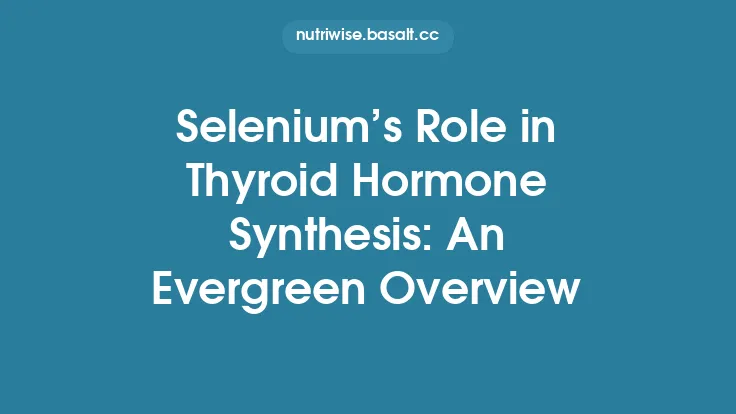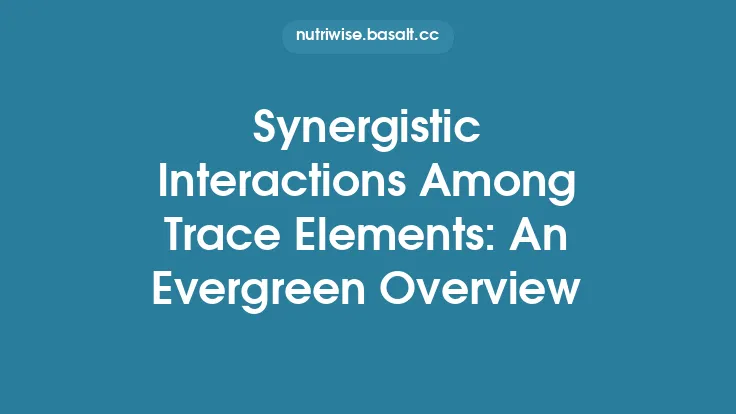Zinc is an essential trace element that underpins the architecture and functionality of the immune system. Its influence extends far beyond simple nutritional adequacy, weaving through the molecular scaffolding of immune molecules, the regulation of intracellular signaling cascades, and the maintenance of physical barriers that constitute the first line of defense against pathogens. This overview distills the enduring, science‑backed principles that explain why zinc remains a cornerstone of immune resilience, regardless of the ever‑evolving landscape of dietary trends and clinical research.
Zinc as a Structural and Catalytic Cofactor in Immune Molecules
At the heart of every biochemical reaction that sustains immune competence lies a metal ion, and zinc is among the most versatile. Approximately 10 % of the human proteome binds zinc, either to stabilize three‑dimensional structures or to serve as a catalytic center. In the immune context, several key protein families depend on zinc:
- Metalloproteases – Enzymes that remodel extracellular matrices and process cytokine precursors require zinc at their active sites. Their activity shapes tissue remodeling during immune surveillance and wound healing.
- DNA and RNA polymerases – Zinc ions coordinate the catalytic cores of polymerases that drive the rapid proliferation of immune progenitor cells during an immune response.
- Superoxide dismutase (Cu/Zn‑SOD) – Although often highlighted for its antioxidant capacity, Cu/Zn‑SOD also modulates redox signaling that influences immune cell activation thresholds.
Because zinc can adopt a tetrahedral coordination geometry, it provides a stable yet dynamic platform for these proteins, ensuring that enzymatic reactions proceed with the precision required for immune homeostasis.
Regulation of Immune Signaling Pathways by Zinc
Zinc’s role as a second messenger has become increasingly evident. Fluctuations in intracellular free zinc concentrations—often termed “zinc waves”—are triggered by receptor engagement, stress signals, or metabolic cues. These transient spikes influence several pivotal signaling axes:
- NF‑κB Pathway – Zinc can inhibit the IκB kinase complex, tempering the translocation of NF‑κB to the nucleus. This modulation helps prevent unchecked transcription of pro‑inflammatory genes, preserving a balanced immune tone.
- MAPK Cascades – By binding to specific phosphatases, zinc fine‑tunes the activation of ERK, JNK, and p38 MAPKs, which are central to cell differentiation and cytokine production.
- JAK/STAT Signaling – Zinc interacts with the SH2 domains of STAT proteins, influencing their dimerization and DNA‑binding affinity, thereby affecting the transcription of genes involved in immune cell maturation.
These regulatory effects are not merely binary “on/off” switches; rather, zinc acts as a rheostat, calibrating signal intensity and duration to match physiological demands.
Zinc and the Integrity of Physical Barriers
Before any cellular immune mechanisms are engaged, pathogens must breach the body’s external defenses. Zinc contributes critically to the structural and functional integrity of these barriers:
- Epithelial Tight Junctions – Zinc stabilizes the protein complexes (e.g., claudins, occludin) that seal intercellular spaces in the gut, respiratory tract, and skin. Adequate zinc levels preserve barrier permeability, limiting microbial translocation.
- Keratinocyte Differentiation – In the epidermis, zinc-dependent enzymes drive the cross‑linking of structural proteins, fostering a robust stratum corneum that resists mechanical injury and microbial colonization.
- Mucosal Secretions – Zinc is a constituent of several secreted proteins, such as lactoferrin, which bind iron and create an environment hostile to microbial growth.
By safeguarding these physical frontiers, zinc reduces the reliance on downstream immune activation, thereby conserving metabolic resources.
Zinc Homeostasis: Transporters, Binding Proteins, and Cellular Distribution
The immune system’s demand for zinc is met through a tightly regulated network of transporters and binding proteins that orchestrate intracellular and intercellular zinc flux:
- ZIP (SLC39) Family – These importers increase cytosolic zinc by moving the ion from extracellular space or intracellular stores into the cytoplasm. Specific ZIP isoforms (e.g., ZIP8, ZIP14) are up‑regulated during immune activation, ensuring a rapid supply of zinc for signaling.
- ZnT (SLC30) Family – In contrast, ZnT transporters export zinc out of the cytosol, either into organelles (e.g., ZnT5 into the Golgi) or extracellularly, preventing toxic accumulation.
- Metallothioneins (MTs) – Cysteine‑rich proteins that sequester excess zinc, buffering sudden changes in free zinc concentration. MT expression is itself zinc‑responsive, creating a feedback loop that stabilizes intracellular pools.
Disruptions in any component of this system can lead to either functional zinc deficiency at the cellular level or toxic overload, both of which impair immune competence.
The Thymus, Zinc, and Lymphocyte Maturation
The thymus is the cradle of T‑cell development, and zinc is indispensable for its structural and functional preservation:
- Thymic Epithelial Cells (TECs) – These stromal cells express high levels of zinc‑dependent transcription factors that guide the expression of major histocompatibility complex (MHC) molecules essential for positive and negative selection of developing T‑cells.
- Zinc‑Dependent Hormones – The thymic hormone thymulin requires zinc for its biological activity. Thymulin modulates the differentiation of naïve T‑cells into functional subsets, influencing the adaptive arm of immunity.
Age‑related involution of the thymus is accompanied by altered zinc transporter expression, suggesting that maintaining zinc homeostasis may mitigate some aspects of immunosenescence.
Molecular Mechanisms: Zinc Finger Proteins and Gene Regulation
Zinc finger motifs are among the most abundant DNA‑binding domains in the human genome. Their presence enables precise transcriptional control of immune‑related genes:
- C2H2 Zinc Fingers – Found in transcription factors such as SP1 and Ikaros, these motifs bind promoter regions of cytokine genes, immunoglobulin loci, and receptors, dictating expression patterns during immune development.
- RING‑type Zinc Fingers – Integral to ubiquitin ligases, they regulate protein turnover of signaling intermediates, ensuring timely termination of immune responses.
Because the structural integrity of these motifs hinges on zinc coordination, fluctuations in zinc availability can directly reshape the transcriptional landscape of the immune system.
Impact of Zinc Status on Immune System Architecture
Longitudinal studies across diverse populations have demonstrated that systemic zinc status correlates with measurable changes in immune architecture:
- Lymphoid Organ Size – Suboptimal zinc levels are associated with reduced thymic mass and altered splenic follicle organization, reflecting compromised lymphocyte maturation niches.
- Cellular Metabolism – Zinc influences mitochondrial function and glycolytic flux, both of which are pivotal for the energetic demands of proliferating immune cells.
- Microbiome Interactions – Zinc availability in the gut lumen can affect microbial composition, indirectly shaping mucosal immunity through microbial metabolites that signal to host immune cells.
These macro‑level observations underscore zinc’s role as a systemic regulator rather than a mere micronutrient.
Research Insights and Emerging Perspectives
While the foundational functions of zinc in immunity are well established, several frontiers are actively being explored:
- Zinc‑Based Immunomodulators – Small molecules that mimic zinc’s signaling effects are under investigation as potential therapeutics for autoimmune conditions, aiming to harness zinc’s capacity to fine‑tune NF‑κB and MAPK pathways without altering systemic zinc levels.
- Genetic Variants of Zinc Transporters – Polymorphisms in ZIP and ZnT genes have been linked to differential susceptibility to infectious diseases, suggesting a personalized dimension to zinc biology.
- Zinc and Epigenetics – Emerging data indicate that zinc‑dependent histone deacetylases (HDACs) influence chromatin accessibility of immune genes, opening avenues for epigenetic modulation of immunity.
Continued interdisciplinary research will likely expand the repertoire of zinc‑centric strategies for sustaining immune health.
Practical Takeaways for Maintaining Adequate Zinc Levels
Even without delving into specific dosage recommendations, several evergreen principles can help preserve optimal zinc status:
- Diverse Dietary Patterns – Incorporate a variety of foods that naturally contain zinc, ensuring a steady influx of the mineral across meals.
- Balanced Micronutrient Interplay – While this overview does not focus on synergistic nutrients, maintaining overall nutritional balance supports the transporters and binding proteins that manage zinc.
- Gut Health Maintenance – A healthy intestinal environment promotes efficient absorption of zinc; fiber‑rich diets and regular physical activity contribute positively.
- Monitoring Health Changes – Periodic health assessments that include markers of zinc status (e.g., plasma zinc, metallothionein expression) can flag early shifts before clinical symptoms emerge.
- Professional Guidance – Individuals with chronic conditions, gastrointestinal disorders, or those undergoing life‑stage transitions (e.g., adolescence, menopause) should consult healthcare providers to tailor strategies that safeguard zinc homeostasis.
By embedding these practices into daily life, individuals can harness the timeless, protective power of zinc to sustain a robust immune system throughout the lifespan.





